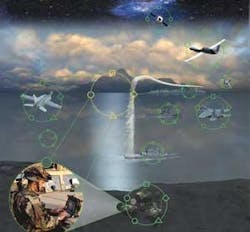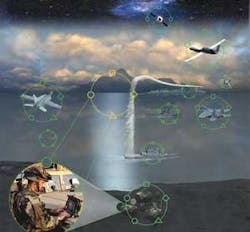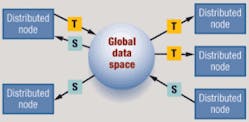Defense planners today are planning tomorrow’s battles around the concept of a network-centric force by connecting all the elements-land, sea, air-into one networked force; the soldier sees what the pilots see, and what the sailors see. Key technologies include Internet Protocol, software-defined radio, and wireless networking.
By John McHale
The deciding factor in the first Gulf War was the ability of U.S. forces to fight effectively at night. This advantage multiplied in Gulf War II and the conflict in Afghanistan.
Battlefield elements of the future-tanks, aircraft, ships, and soldiers- all will be nodes within one large networked force; what the individual soldier sees, the tank commander, the pilot, and the sailor sees in real time. Network-centric warfare will take situational awareness to the next level. Battlefield commanders will use these networks to trade voice, data, and video between air, maritime, and fixed stations worldwide.
Many military systems are networked today while standing still. The next step is to network vehicles, soldiers, aircraft, and ships while on the move.
WIN-T
General Dynamics and Lockheed Martin experts are already designing and demonstrating technologies for a network-centric force on the move through the Warfighter Information Network-Tactical (WIN-T), the U.S. Army’s next-generation battlefield network backbone.
The companies completed demonstrations of WIN-T technologies earlier this year, confirming that technologies and subsystems in the next-generation warfighter network are mature and significantly reducing risk for fighting forces, General Dynamics Officials say.
“The WIN-T tests are on track, on time, and on schedule,” says U.S. Army Col. Angel Colon, the WIN-T program manager. “These demonstrations show that we’re ready. “
“Mobile satellite communications and the network automation necessary to keep highly mobile and dispersed forces connected are key to WIN-T and the Army,” says Bill Weiss, vice president of future-force networks for General Dynamics C4 Systems in Scottsdale, Ariz. “The WIN-T program is on track and we look forward to delivering these key technologies to support the warfighter.”
The vision of WIN-T, Weiss explains, “is giving warfighters access to critical battlefield information, seamless connectivity to the global information grid, unified network operations, joint interoperability, and security across a host of platforms and points of presence.”
During the demonstrations, which took place throughout the summer, General Dynamics and its teammates displayed on-the-move technologies that are some of the most critical challenges in the program. These include radio, cellular, satellite, and Internet protocol (IP) capabilities designed to keep warfighters in touch and connected to the network, whether they are on the ground or in moving vehicles.
Technical capabilities demonstrated in the tests included on-the-move networking over terrestrial and satellite links, voice- and video-over-IP, networking waveforms, software-defined radios, self-healing networks, satellite tracking and adaptive signal retrieval, network management, information assurance, information dissemination management, real-time situational awareness, network security, and secure cellular telephone communications.
Software-defined radio technology forms part of the architecture, yet WIN-T does not rely on the Joint Tactical Radio System, Weiss says.
WIN-T is a secure, high-bandwidth, wireless communications network that will link battlefield soldiers to voice, data, and video. It will encompass intelligence, surveillance, and reconnaissance systems, as well as netted weapons and the Future Combat Systems (FCS). WIN-T will be integrated with the Future Combat System vehicles and as with a cell-phone system being developed for individual soldiers, he says.
The critical advantage of WIN-T is its ability to give commanders the right information at all times, even when forces are moving-a capability not widely available today. That is the key enabler of WIN-T-to provide network connectivity while on the move, he says.
In a larger sense, WIN-T is one of four enabling technologies in the Pentagon’s effort to transform today’s military into a smaller, faster, more lethal force. In this vision, WIN-T and the Joint Tactical Radio System (JTRS) act as mobile battlefield networks, connected to two permanent, high-bandwidth pipelines-a terrestrial network called the Global Information Grid Bandwidth Expansion (GIG-BE) and a space-based network called the Transformational Satellite Communications system, or TSAT.
Army leaders pushed this plan forward when they approved plans in the preliminary design review (PDR), the “first draft” of the WIN-T system design, including the top-level architecture and key component technologies. The system replies on a combination of communications technologies, including third-generation cellular, wireless LAN, next-generation satellite, IP version 6, and voice over IP.
The WIN-T contract, worth $7 billion through 2018, was awarded in September 2004 to a team of General Dynamics C4 Systems in Taunton, Mass., and Lockheed Martin in Gaithersburg, Md. They report to the Army’s Communications and Electronics Command in Ft. Monmouth, N.J.
Operational test of WIN-T will be performed in 2008 with operational capability expected in 2009, Weiss says
WIN-T also serves as the tactical extension of the Global Information Grid and is interoperable with joint forces, coalition forces and other government agency networks. General Dynamics leads a team of communications, network systems and platform integration experts on the program, including Lockheed Martin, BAE Systems, and Harris Corp.
Adaptive Joint C4ISR Node
Engineers at BAE Systems in Nashua, N.H., are providing real-time network-centric communications with the Adaptive Joint C4ISR (command, control, communications, and computer, intelligence, and reconnaissance) Node program, better known as AJCN.
The AJCN demonstration will deliver a scalable, multimission payload that can perform communications, SIGINT (signals intelligence) and electronic warfare information operations (EW/IO). It will be reconfigurable to perform a variety of functions within the same processing hardware.
AJCN enables a wide area network from the air with a common data link integrating all elements of C4ISR, says Matt Merryman, senior manager, business development at BAE Systems. It is a multimission platform that is fully scaleable and uses commercial-off-the-shelf technology, he adds. The U.S. Army and Air Force will be key users of the C4ISR node.
Today, AJCN capabilities include porting and integrating new and legacy JTRS waveforms onto an open-architecture multimission system. The AJCN multi-mission software framework combines two key BAE Systems elements: the SIGINT Diamond Software product family framework, and the JTRS framework.
The demonstration program will build a secure communications relay capability on the AJCN. The program combines several key capabilities including SIGINT, networking, wideband waveforms, software-programmable radio products, and multilevel information security architectures.
It is not JTRS but uses a similar concept, is Software Communications Architecture compliant, and can coexist with JTRS, Merryman says.
The C4ISR node is designed to operate with U.S. and coalition systems and provide real-time network-centric connectivity. BAE Systems will design, build, and deliver the payloads, which will be flight-tested on the Army’s Hunter Unmanned Air Vehicle (UAV) and on larger manned and unmanned Air Force aircraft.
The Defense Advanced Research Projects Agency (DARPA) in Arlington, Va., originally awarded the AJCN contract to BAE Systems. Under the five-year program, BAE Systems manages the systems engineering, as well as the signals intelligence, electronic attack, and systems integration efforts.
System of elements
Experts at Raytheon Network Centric Systems in McKinney, Texas, have developed a concept they say is the next step in the network-centric evolutionary process, beyond what AJCN and WIN-T will provide.
The concept is the Joint Common Decision and Execution Capability (CDEC), says Thomas Flynn, director of strategy initiatives for Raytheon Network Centric Systems.
It integrates engagement operations and force operations such as “integrated fire control, common 3-D truth/combat ID, and automated battle management aides and logistics planning. CDEC provides predictive planning and maintains a distributed, remoted, nondedicated environment.
Operations in the future will use less and less people and most aircraft will be unmanned, Flynn says. Battlefield elements will need to be interdependent and part of one system, he adds.
Flynn says his military customers have some common themes for future battles. They want to fight jointly, interagency, and multinational; to mass effects, not forces; to fight nonlinearly; to influence two to three more times battlespace than they do today; and to be ready to fight more quickly.
Flynn’s solution is what he calls a system of elements networked together to be one entity. “The system of elements is remoted, distributed, and nondedicated. Many people ask me where is the network,” Flynn says. “I answer that there is no network; a network is what happens when a problem needs to be solved. We came up with five key elements that every application would have in common-platform, communications, command and control, sensor, and effector-an effector is any element that brings combat force to bear,” Flynn says.
Internet Protocol is the key enabler for Flynn’s vision. Each element of the battlefield will have an IP address-a soldier, his weapon, his gunsight, etc. It will be the same for land vehicles, aircraft, and sea vessels, Flynn says.
Network-centric warfare in the past basically consisted of radio-connected platforms, Flynn says. Today’s deployed forces are into the digitization age and have local area connectivity. Today’s network-centric operations focus on a system of systems, Flynn says. For example an ad hoc Internet voice over IP connectivity, which results in single integrated air/single integrated ground pictures, he explains.
“The human body is an example of a system of systems,” Flynn says. However, if one of those systems such as eyesight fails, it cannot be replaced. This is similar to a military battlefield where if one of the systems of systems, such as a surveillance aircraft, loses key sensors it is removed from the battlefield because it becomes a liability, Flynn says.
If one of those surveillance planes were to lose a visual sensor, another plane in the squadron would automatically give that plane the view it had lost, Flynn says. It is the same with the person who goes blind, he continues. He would still see, but with the eyes of the person next to him, Flynn says.
On Sept. 11, 2001, there was nothing key personnel on the ground could do as soon as the terrorists hijacked the aircraft; personnel on the ground had lost control. If the plane had been part of a system of elements things may have turned out differently, Flynn says.
A system of elements would not always be the solution; sometimes a system of systems works just fine. Raytheon’s first application for a system of elements involves an air traffic management application. Flynn says he is in discussions with U.S. Department of Defense officials who, he says, are very interested in the concept.
Some of the technology necessary to develop the CDEC is available today but much has yet to be developed. The predictive planning aspects need breakthroughs in artificial intelligence. Algorithmic-intensive developments such as multilevel security and fusion engines are also technologies that have yet to arrive, Flynn says.
Ultimately it will be necessary to be hardware independent because processors and other devices become obsolete so quickly, Flynn says.
DRS Technologies provides battlefield digitization systems for the U.S. Army
DRS Technologies in Parsippany, N.J., continues to deliver rugged Appliqué computer systems for the U.S. Army’s Force XXI Battle Command, Brigade and Below (FBCB2) program. The systems support U.S. Army units engaged in Iraq and Afghanistan.
DRS is the sole-source supplier for the Appliqué computers to the Army, says Al Zimmerman, the company’s executive vice president of tactical computing. “We designed the system from the bottom up,” he says, using commercial off-the-shelf, or COTS, components.
Installed on M1A2 Abrams main battle tanks and M2A3 Bradley Fighting Vehicles, these FBCB2 systems support the Army’s Blue Force Tracking requirements, which include beyond-line-of-sight reporting and tracking, as well as information integration. The computers have been integrated into 27 different front-line Army vehicles, Zimmerman says.
The FBCB2 program focuses on developing a digital battle command information system designed to improve command-and-control information battlefield commanders and their soldiers in the field. The system supports the Army battlefield visualization, and provides a seamless flow of battle command information based on its interoperability with external command and control and sensor systems.
U.S. Army’s Communications-Electronics Command (CECOM) at Fort Monmouth, N.J., awarded DRS the contract. DRS provides rugged computer hard disk drives, display units, keyboard units, and upgraded processor units with one gigabyte of DRAM solid-state memory. The DRS Tactical Systems unit in Palm Bay, Fla., performs the work for this contract.
“The FBCB2 systems have proven to be crucial assets for our forces in Iraq as part of the Army’s network-centric communications infrastructure by providing improved interoperability and networked battlefield command information,” says Steven T. Schorer, president of the DRS C4I Group.
The FBCB2 system improves combat support, real-time command and control capabilities, interoperability, and situational awareness. The system is to support real-time situational awareness, target identification, and graphical combat-area displays.
The situational awareness component will display the geographical location of all weapons, platforms, soldiers, command posts, and other facilities, and will work with the Army’s Tactical Internet (TI)-a seamless Internet connection to help ease communications. The TI interfaces with the Army Battle Command Systems (ABCS), collects information from both the operation center and the individual units and then disseminates it through FBCB2 computers for improved situational awareness.
The COTS-based Appliqué, also called the DRS RVS-330 Rugged Vehicle System, operates harsh environments and is designed to progress with technology. Expansion capabilities allow for user customization to suit a variety of needs. In addition, the RVS-330’s sunlight-readable display provides resolution conducive to intense operation in all temperature extremes.
The Appliqué uses a 600-MHz Intel Pentium III microprocessor, a removable internal 10-gigabyte hard drive expandable to more than 28 gigabytes. The computer has an operating range of -35 to 50 degrees Celsius.
DRS also provides a similar computer system for the United Kingdom’s Bowman program, Zimmerman says.
Rockwell Collins delivers 40,000 DAGRs for U.S. troops
Rockwell Collins in Cedar Rapids, Iowa, delivered 40,000 Defense Advanced Global-positioning-system (GPS) Receivers (DAGR) for U.S. warfighters, company officials announced during the AUSA Annual Meeting and Exposition at the Washington Convention Center in October.
Building on the company’s Precision Lightweight GPS Receiver (PLGR), with more than 200,000 units delivered worldwide, the Rockwell Collins DAGR incorporates five times the capabilities and functions of the PLGR while reducing the overall size, weight, and power requirements, Rockwell officials say. Rockwell Collins was selected for full-rate production of DAGRs in 2003.
Primarily used by the U.S. Army, the DAGR is considered the handheld standard for GPS position and navigation, company officials say. The receiver provides precise timing to synchronize tactical radios for the U.S. Army’s digital battlespace and includes a graphical user interface that enhances the soldier’s effectiveness and safety.
Additionally, the DAGR incorporates anti-jam improvement for enhanced protection and is the first U.S. program to include the next generation security device, Selective Availability Anti-Spoofing Module (SAASM), for handheld GPS receivers, company officials say.
Data-Distribution Service standard seen as a fit for command-and-control applications
Electronics industry experts say the recently adopted Data-Distribution Service for Real-Time Systems (DDS) standard could bring publish-subscribe data-distribution technology to military battle management.
These predictions come from leaders at Real-time Innovations in Santa Clara, Calif. The DDS standard comes from the Object Management Group (OMG) Inc. in Needham, Mass.
“The Department of Defense Global Information Grid (GIG) vision is to empower users through easy access to information anytime and anyplace, under any conditions,” says Gerardo Pardo-Castellote, chairman of the DDS Standards Committee and chief technology officer of Real-Time Innovations.
To this end, he says, many applications and processes will need to evolve and become net-centric, hence the need for network middleware technology-the software fabric that allows computer programs to “talk” and easily exchange information over the Internet.
The GIG involves complex dataflows with differing requirements for real-time performance, reliability, fault tolerance, dynamic configuration changes, and scalability, Pardo-Castellote explains. “The GIG environment reflects the fluid and ever-changing nature of the real world.”
Dataflows can involve one to many, many to one, and many to many. Real-time performance can vary with update rates, latency, and bandwidth. Fault tolerance can involve redundancy, automatic failover, or no single point of failures.
“There are many kinds of network middleware, each suited for specific information needs and network/computation environments,” Pardo-Castellote says. Engineering tradeoffs have been made to address the different aspects of field and headquarters computers, which results in the lack of a “one size fits all” solution, he says.
The computation, power, and bandwidth capabilities of a soldier-wearable handheld computer are not comparable to those of an operations-center cluster, he points out.
“DDS uses a publish-subscribe approach to let application developers and system integrators focus on the logic of the applications and communicate by publishing the information they have and subscribing to the information they need,” Pardo-Castellote says. “DDS handles automatic discovery, reliability, and redundancy over otherwise unreliable networks.
Pardo-Castellote says that DDS has built-in redundancy, lack of centralized logic, and strength arbitration logic-all of which facilitate the development of a fault-tolerant system ideal for network-centric warfare applications.
DDS can handle format conversion across operating systems, processor architectures, and programming languages, which lends it to the heterogeneous dynamic environments introduced by increased wireless use within the GIG, Pardo-Castellote says.
The Object Management Group finalized the Data-Distribution Service for Real-Time Systems Specification in 2004 (www.omg.org/cgi-bin/doc?ptc/2004-03-07).
“Despite the novelty, the technology is well proven,” Pardo-Castellote says. “The DDS standard unifies some of the best practices present in successfully deployed real-time data-distribution middleware such as NDDS from Real-Time Innovations and SPLICE from Thales.”
DDS allows applications to use a much simpler programming model when dealing with distributed data-centric applications.
Instead of developing custom event and messaging schemes, or creating wrapper CORBA objects to access data remotely, the application can identify the data it wishes to read and write using a simple topic name. Then it uses a data-centric application-programming interface to read and write the data directly.
The Navy Open Architecture Computer Environment (Navy OACE) and the Defense Information Technology Standards Registry (DISR) mandate DDS. The standard has been adopted for programs such as Future Combat Systems, DDX Destroyer, Littoral Combat Ship, and the Ship Self-Defense System (SSDS), he says.







